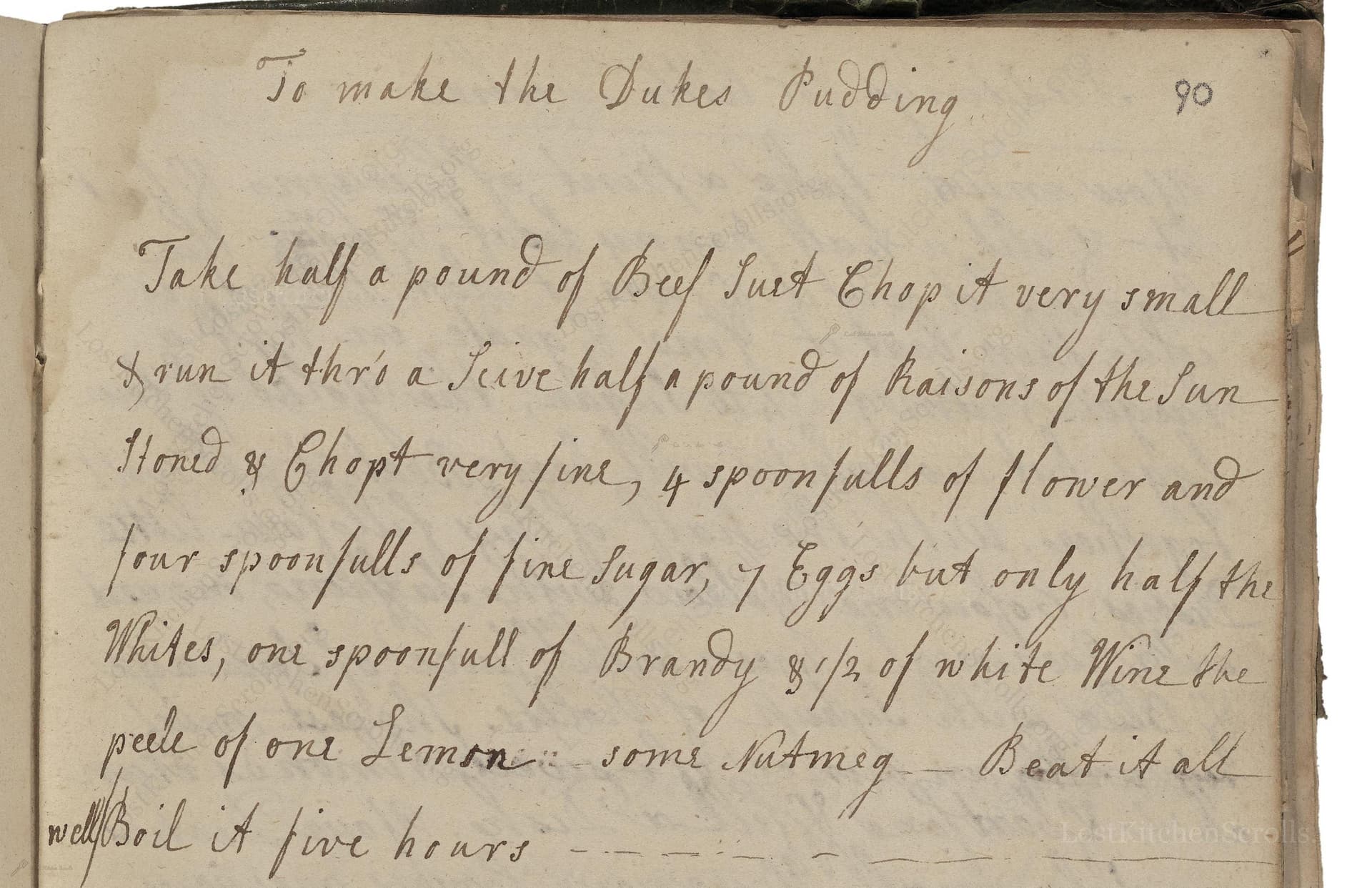To Make The Dukes Pudding
From the treasured pages of Cookery book of Jane Webb, compiled by several people
Written by Jane Webb

To Make The Dukes Pudding
"Take half a pound of Beef Suet Chop it very small & run it thro a Seive half a pound of Raisons of the Sun Stoned & Chopt very fine, 4 spoonfulls of Flower and four spoonfulls of fine sugar, 7 Eggs but only half the Whites, one spoonfull of Brandy & 1/2 of white Wine the peele of one Lemon :: some Nutmeg -- Beat it all well Boil it five hours ----"
Note on the Original Text
The recipe reflects the informal, narrative style common in early modern manuscripts, dispensing with precise measurements and assuming deep kitchen knowledge. Directions are condensed and lack time or temperature guidance, as cooks relied on experience and observation. Spelling deviates from modern norms ('Flower' for flour, 'Raisons of the Sun' for raisins), and punctuation is minimal. The use of ampersands and dashes to connect ideas is characteristic of the era's manuscript cookery.

Title
Cookery book of Jane Webb, compiled by several people (1738)
You can also click the book image above to peruse the original tome
Writer
Jane Webb
Era
1738
Publisher
Unknown
Background
A delightful glimpse into the culinary world of early 18th-century England, this manuscript offers a playful array of recipes and kitchen wisdom, reflecting the tastes and ingenuity of its era.
Kindly made available by
Folger Shakespeare Library
The recipe comes from the mid-18th century, authored by Jane Webb, who was active between roughly 1725 and 1750. This was a period when English country house kitchens embraced luxurious boiled or steamed puddings, thick with costly ingredients like suet, eggs, and dried fruit, reflecting the affluence of the gentry and nobility. Such puddings, named after noble patrons like the "Duke," were status symbols and centerpiece desserts at great tables, blending medieval traditions with newly fashionable ingredients like refined sugar and brandy. The use of suet shows both thrift (using all animal parts) and the beginnings of what would become the classic British steamed pudding tradition.

Historically, this pudding would have been made by finely chopping suet with a heavy kitchen knife on a broad wooden board, then pushing it through a fine sieve. The mixing was done by hand in large earthenware bowls. The pudding would be boiled in a cloth, tied securely and suspended in a cauldron or large iron pot over an open hearth. Alternatively, it might be made in a mould and placed in a water-filled pan to simmer gently for several hours. Long-handled wooden spoons and strong string were essential tools.
Prep Time
30 mins
Cook Time
5 hrs
Servings
8
We've done our best to adapt this historical recipe for modern kitchens, but some details may still need refinement. We warmly welcome feedback from fellow cooks and culinary historians — your insights support the entire community!
Ingredients
- 8 oz beef suet (or 8 oz grated cold unsalted butter as substitute)
- 8 oz raisins (seedless, chopped finely)
- 1.5 oz plain flour
- 1.75 oz caster sugar
- 7 eggs (use only 3–4 egg whites, use all yolks)
- 1 tablespoon (0.5 fl oz) brandy
- 1/2 tablespoon (0.25 fl oz) dry white wine
- zest of 1 lemon
- freshly grated nutmeg (about 1/4 teaspoon)
Instructions
- Begin by chopping 8 oz of beef suet (or substitute with 8 oz of grated cold unsalted butter if suet is unavailable) as finely as possible, then press it through a fine sieve for a smooth texture.
- Take 8 oz of seedless raisins and chop them very finely.
- In a large bowl, combine the suet, raisins, 4 tablespoons (about 1.5 oz) of plain flour, and 4 tablespoons (about 1.75 oz) of caster sugar.
- Beat 7 eggs but use only about 3–4 egg whites, not all.
- Stir into the mixture, then add 1 tablespoon (about 0.5 fl oz) of brandy and ½ tablespoon (about 0.25 fl oz) of dry white wine.
- Zest the peel of one lemon into the mixture and grate in a pinch of nutmeg.
- Mix thoroughly to form a thick batter.
- Spoon the mixture into a well-greased pudding basin or similar heatproof mould.
- Cover tightly with baking parchment and foil, tying securely with string.
- Place the basin in a large pot, adding boiling water to reach halfway up the sides.
- Steam or boil gently for five hours, topping up the water as needed.
- Carefully lift out and allow to cool for 10–15 minutes before unmoulding.
- Serve warm, optionally with a dash more brandy or a drizzle of lemon sauce.
Estimated Calories
420 per serving
Cooking Estimates
It takes about 30 minutes to prepare the ingredients, and the pudding needs to steam for five hours. The finished pudding can serve about 8 people, and each serving contains roughly 420 calories.
As noted above, we have made our best effort to translate and adapt this historical recipe for modern kitchens, taking into account ingredients nowadays, cooking techniques, measurements, and so on. However, historical recipes often contain assumptions that require interpretation.
We'd love for anyone to help improve these adaptations. Community contributions are highly welcome. If you have suggestions, corrections, or cooking tips based on your experience with this recipe, please share them below.
Join the Discussion
Rate This Recipe

Den Bockfisch In Einer Fleisch Suppen Zu Kochen
This recipe hails from a German manuscript cookbook compiled in 1696, a time whe...

Die Grieß Nudlen Zumachen
This recipe comes from a rather mysterious manuscript cookbook, penned anonymous...

Ein Boudain
This recipe comes from an anonymous German-language manuscript cookbook from 169...

Ein Gesaltzen Citroni
This recipe, dating from 1696, comes from an extensive anonymous German cookbook...
Browse our complete collection of time-honored recipes



